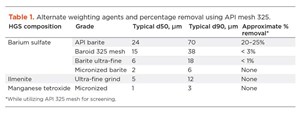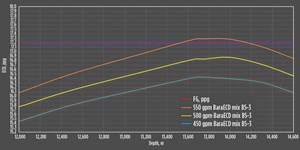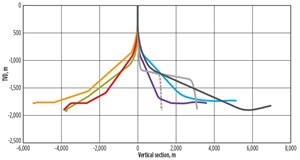Innovative fluid designs offer operators streamlined solutions
Today, operators face reduced capital expenditures (CAPEX), while requiring versatile and efficient solutions to drill and complete their reservoirs. Typically, well construction programs use multiple drilling and completion fluid sets, with barite-weighted non-aqueous fluids (NAFs) to drill the final section, followed by solids-free brines to install the completion hardware.
Although a range of low-density brines is widely available, heavier fluids have become limited in supply, thus drastically increasing well costs. Swapping NAFs for high-density brines can also cause chemical instabilities in reservoirs containing sensitive shales. Moreover, drilling reservoirs with standard-weighted NAFs has limitations—such as high solids and invasion potential, poor filter-cake cleanup with insoluble solids, barite sag, and high equivalent circulating densities (ECDs) that can lead to wellbore instabilities and non-productive time (NPT).
RESERVOIR FLUID ADAPTATIONS
Advanced fluid designs in recent years can achieve very low ECDs, with some also providing superior sag resistance. Halliburton Baroid offers the BaraECD and BaraXcel high-performance NAF systems, which can achieve both aims, making them ideal for low-pressure formations, extended-reach drilling, high-angle drilling, and slim wellbores. These organophilic clay-free NAFs have a rheological profile designed to provide low and controlled ECDs, and to allow for greater wellbore stability. They also have the capability to continuously treat weak and fractured formations, with the addition of wellbore-strengthening materials.
Another advantage of BaraECD and BaraXcel NAF systems is that they can be engineered with heavy brines to increase fluid density and reduce the solids required, thus lowering drilling ECD and sag potential. For example, calcium bromide brine can be used in place of the typical calcium chloride brine phase to allow BaraECD and BaraXcel NAFs to achieve densities upward of 12.5 lb/gal, with only BaraCarb sized ground marble. This eliminates the need for barite high gravity solids (HGS) entirely, allowing for lower ECDs and improved clean-up with acid.
With proprietary zinc- and formate-free brine technology now reaching up to and beyond 14.8 lb/gal (1.77 sg), the HGS-free approach to reservoir NAFs can be extended to the 13.5-lb/gal-to-14-lb/gal (1.62-sg to 1.68-sg) fluid density range for higher-pressured formations. Above this range, where HGS is required, higher-density brines may not achieve great benefits. If high density and full acid solubility are required (for instance with injection wells), then alternate HGS, such as ilmenite and manganese tetroxide, can be considered.
PROACTIVE FLUID DESIGN
Applications of API standard barite present challenges for screened completions, since a large fraction of the weight material could plug completion equipment and sand screens, and would need to be removed before installing screens. Large barite particles also have the highest susceptibility to sagging. To expand the utility of BaraECD NAF for reservoir applications, Halliburton has migrated to alternate weighting agents. The portfolio now includes Baroid 325 mesh, barite ultra-fine, and micronized barite weighting agents to tailor fluid solutions for various completion hardware and the required levels of sag resistance, Table 1.
While these options provide for greater completion compatibility, another key aspect of planning is to ensure that the rheological profile of the fluid will allow wellbore pressures to stay below the fracture gradient (FG) and enable successful drilling operations. Laboratory design work is performed to help select the best material grade, in parallel with hydraulics simulations to optimize the rheological properties.1
Output from Baroid’s Drilling Fluids Graphics (DFG) software shows the predicted ECD values plotted against the measured depth in an example well section, Fig. 1. The proprietary algorithms derive these values from inputs that include the detailed well and drillstring geometry, temperature gradients, and drilling parameters, as well as the candidate fluid properties. Accurate ECD predictions, relative to the planned FG, improve confidence in well programming and enhance team collaborations around risks and contingency plans.
Operators can expect heightened efficiency, as long as these fluid systems are maintained within specifications. Then the goal shifts to execution with optimum operating parameters. Drillstring movements, cuttings loads, and flowrates all significantly impact downhole pressures. When all inputs are accurate, the predicted ECDs find excellent correlations to downhole measurements, Fig. 2. In this case, an updated version of the DFG model was applied to a previously drilled well. The simulation line closely tracked the pressure-while-drilling (PWD) sub, through to the target depth.
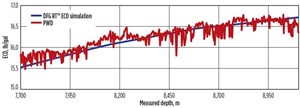
Wells with narrow operating windows benefit greatly from augmenting the hydraulic simulation software with real-time monitoring services. Baroid software can create a digital simulation of the wellbore in real time. It uses physics-based models to accurately adjust for changes in rheological profiles related to temperature fluctuations, along with volume changes in the base fluid fraction, cuttings volumes in the well, and additional drilling nuances due to pipe rotation speeds and other effects.
COMPLETION MODE
Especially in extended-reach wells, during the installation of completion hardware and during wellbore cleanout activities, a good NAF should be able to avoid plugging sand screens and be lubricious enough to facilitate the installation of the completion to the desired total depth in a deviated well. NAFs are also often selected to overcome the torque and drag constraints of an aqueous fluid system.
The time taken to successfully condition the NAF into production screen testing (PST) specification is highly contingent on the amount of drill solids, along with the NAF’s hole cleaning efficiency during the drilling phase, the quantity and particle size of the solids contained within the fluid, and the aperture size of the sand control screen being deployed. Figure 3 demonstrates a lack of screen plugging after a PST check from a carefully engineered and conditioned HGS-free NAF system deployed offshore Norway. Fluids formulated with API barite can take several hours and even days to condition, especially if sub-200-micron sand screens must be installed. It has been demonstrated in the field that this time can be reduced to less than four hours by engineering an HGS-free system, including a calcium bromide brine internal phase to permit a reduction in overall solids loading.2
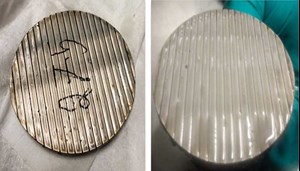
Case Study 1 - Gulf of Mexico. In ultra-deepwater environments, drilling and completion operations demand extremely large fluid inventories. Consequently, simplifying operations and selecting the right fluid are key elements for reducing costs and enabling narrow-margin wells to be drilled while avoiding lost circulation and well control issues.
Working in collaboration with a Gulf of Mexico operator during the planning phase, the Halliburton team identified that the reservoir rock was highly water-sensitive and recommended its BaraECD NAF, because this fluid offered superior weight material suspension at a lower rheology, compared to traditional organoclay-containing fluid systems. Additionally, the fluid could be conditioned at the target depth without damaging the formation, while also being used as a completion fluid. As a result, the operator drilled the reservoir sections of two ultra-deepwater wells without experiencing any fluid losses despite the narrow-mud-weight window.
By engineering BaraECD NAF to serve as a dual-purpose fluid system, the team delivered significant economic value for the operator by achieving a lower project break-even cost per barrel, and saving three days of rig time that was valued at an estimated $3 million.
Case Study 2 - UAE. Halliburton has drilled three of the longest wells in the world, offshore the United Arab Emirates. Engineering a multi-purpose fluid approach, the team used a BaraXcel organoclay-free NAF as a drill-in and liner-running fluid, consisting of a heavy calcium bromide brine internal phase to allow the solids component to be completely acid soluble. Due to the length and deviation of the wells, with one of the runs being over 25,000 ft/7,620 m—a world record—installing slotted liners in an aqueous environment was not possible.
The N-FLOW delayed-release filter-cake breaker system was pumped, once the lower completions were installed. The volumes of breaker required to treat these extremely long reservoir sections were in excess of 1,000 bbl. To ensure optimal fluid placement, maximize productivity, and allow for even treatment of the en tire productive zone, delay times for the treatments were engineered to be at least 4 to 5 hr.
Case Study 3 – ERD applications. The shallow true vertical depth (TVD) for some reservoirs leads to high ECDs, reaching 3–5 lb/gal over surface density. An operator drilling 8½-in. reservoir sections beyond 40,000 ft required a specialized BaraECD NAF system to ensure that the ECD would stay within the FG limit. Ultra-fine ilmenite material was selected, since it could be pneumatically conveyed. The Halliburton team tested extended sag stability in the laboratory and at the rig site, verifying adequate suspension for multiple days.
This first well presented challenges of moderate measured depth with tight ECD limits. The fluid rheology profile was managed carefully to sustain ample drilling rates, with respect to time and to reach the target depth without exceeding the pressure limit. The results validated both the new fluid system and predictive DFG software enhancements, allowing for increased confidence in planning the second well.
The second well had much longer depth with similar TVD. The Baroid software predicted ECDs by closely tracking downhole sensors for both wells, enabling trouble-free drilling and achieving efficient fluid filtration over API 325 -mesh screens before reaching the target depth, Fig. 4. Deploying BaraECD NAF for drilling and completion installations helped the operator save time for displacement and simplified volume management at the surface.
VALUE ADDED
Halliburton Baroid offers a collaborative and reservoir-centric approach that bridges the gap between drilling and completion. The Baroid team’s proven reservoir knowledge and technical expertise have been earned from solving multiple challenges across the globe's major producing basins. Combining innovative fluid designs, such as BaraECD and BaraXcel NAF systems, with world-class DFG-RT digital twin technology provides streamlined fluid solutions for accessing previously inaccessible reservoirs, while reducing rig time and maximizing overall asset value.
REFERENCES
- Zhou, H., D. Chesnee, J. Deville, W. Shumway, R. Schiro, T. Bailey, R. Valenziano, and D. Carbajal, “Hydraulic modeling helps designing ultralow ECD nonaqueous fluids to meet narrow ECD windows,” paper SPE-192951, presented at the Abu Dhabi International Petroleum Exhibition & Conference, Abu Dhabi, UAE, Nov. 12-15, 2018.
- Webber, C. and M. Langford, “An innovative fluid approach to reservoir drilling and sand screen deployment: When reality meets design and the lessons learned,” paper SPE-193186, presented at the Abu Dhabi International Petroleum Exhibition & Conference, Abu Dhabi, UAE, Nov. 12-15, 2018.
- Advancing offshore decarbonization through electrification of FPSOs (March 2024)
- U.S. oil and natural gas production hits record highs (February 2024)
- What's new in production (October 2023)
- FPSO technology: Accelerating FPSO performance evolution (September 2023)
- What's new in production (August 2023)
- A step-change in chemical injection (August 2023)
- Applying ultra-deep LWD resistivity technology successfully in a SAGD operation (May 2019)
- Adoption of wireless intelligent completions advances (May 2019)
- Majors double down as takeaway crunch eases (April 2019)
- What’s new in well logging and formation evaluation (April 2019)
- Qualification of a 20,000-psi subsea BOP: A collaborative approach (February 2019)
- ConocoPhillips’ Greg Leveille sees rapid trajectory of technical advancement continuing (February 2019)

